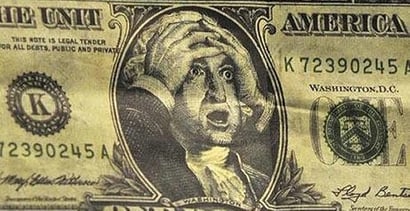

Experts can’t agree on the exact number, but analysts say the average American household has between $8,000 and $12,000 in debt, based on several measures. However, one things number crunchers can agree on is the size of the United States’ national debt.
The national debt level is considered one of the most important public policy issues — and as of Feb. 5, 2015, the official debt of the United States government stands at a little more than $18.1 trillion ($18,147,256,483,854.60), according to the U.S. Treasury. That amounts to roughly $56,660 for every person living in the U.S.
Does the national debt know no bounds?
Just like its citizens, the U.S. has a credit limit.
The debt limit or “debt ceiling” is essentially a self-imposed credit limit set by Federal lawmakers. It’s the total amount of money the United States government is authorized to borrow to meet its existing legal obligations, including Social Security and Medicare benefits, military salaries, interest on the national debt, tax refunds and other payments, according to the U.S. treasury.
The debt limit does not authorize new spending commitments but allows the government to finance existing legal obligations. The last debt ceiling or credit limit was $17.9 trillion. However in February 2014, the Temporary Debt Limit Extension Act was passed allowing for suspension of the debt ceiling until March 15, 2015.
What is the national debt made of?
There are two components that make up national debt: public and intragovernmental debt.
Public debt is defined by the U.S Treasury as “all federal debt held by individuals, corporations, state or local governments, Federal Reserve Banks, foreign governments and other entities outside the United States Government less Federal Financing Bank securities.” Examples of publicly held securities include Treasury Bills, Notes, Bonds, TIPS, United States Savings Bonds and State and Local Government Series securities.
Intragovernmental debt is comprised of government holdings like Medicare and Social Security trust funds and Federal Financing Bank securities.
One nation under debt
Debt is deep-rooted in the U.S. It dates back to the days when the country was born, America’s founding fathers sunk the fledging country into debt borrowing from the French to fund the quest for independence. Debt has been a part of the country’s operations ever since.
Congress gained the power to borrow money against the U. S.’s credit in Article 1 Section 8 of the U.S. Constitution. It’s liberally used this power since 1791. Since then, America has only had one year — 1836 — when it didn’t carry any federal debt.
But that doesn’t mean the U.S. has always been this far in debt.
The size of America’s national debt rises and falls depending upon whether there is an annual budget surplus or deficit. But debt has generally been on the rise since the mid- 1970s.
Despite the price tag, the U.S. going deeper in debt is typically accepted by the public as long as it stimulates the growth of the economy and contributes to its long-term prosperity. However, the government often adds to the national debt to fund Medicare, Social Security and Medicaid.
Then what is the national deficit?
The national debt is the sum of all money the federal government owes to outside entities. Every year the government develops a budget with revenue that includes money paid by taxpayers and expenses like entitlement payments (Medicaid, Social Security, etc.), interest on the debt and defense spending.
Just like the average household, the U.S. has to make ends meet. If the government spends more money than it earns or takes in, it runs a deficit. If more money comes in than is spent, the U.S. runs a surplus. If the government happens to spend the exact amount it takes in, lawmakers have a balanced budget. However, balanced budgets rarely exist.
And if the government spends more than it earns or runs a deficit, it has to look elsewhere — like loans or the equivalent of a credit card — to stay afloat.
Instead of looking to a relative or applying for a credit card to keep itself afloat, the government borrows money by issuing treasury bonds, bills and notes at public auctions.
The largest holders of U.S. debt are China, Japan and Belgium. However domestic private investors, federal governmental agencies, the Federal Reserve Bank, state and local governments and other entities also hold some of the U.S.’s debt.
Just like the average American household, the Federal government needs to keep a watchful eye on debt. And when appropriately, debt can foster the long-term growth and prosperity of a country like the U.S. or an individual trying to boost his or her credit score.
However, whether to build credit or bolster an economic outlook, all debt — household or Federal — requires constant monitoring to understand the amount of interest paid versus the impact on credit.
Photo credit: theodoresworld.net
Advertiser Disclosure
BadCredit.org is a free online resource that offers valuable content and comparison services to users. To keep this resource 100% free for users, we receive advertising compensation from the financial products listed on this page. Along with key review factors, this compensation may impact how and where products appear on the page (including, for example, the order in which they appear). BadCredit.org does not include listings for all financial products.
Our Editorial Review Policy
Our site is committed to publishing independent, accurate content guided by strict editorial guidelines. Before articles and reviews are published on our site, they undergo a thorough review process performed by a team of independent editors and subject-matter experts to ensure the content’s accuracy, timeliness, and impartiality. Our editorial team is separate and independent of our site’s advertisers, and the opinions they express on our site are their own. To read more about our team members and their editorial backgrounds, please visit our site’s About page.




